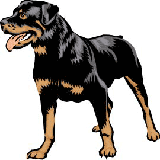Dog Parasite InformationDog Flea Detection |
|
|
Every time you give your dog his regular grooming session, it is very important that you carefully examine his coat and skin. Aside from making sure that the coat and skin are clean and have a pleasant smell to them, you should also check to make sure that he is not playing host to any type of parasite that could trigger the start of various diseases and other several problems. One very common parasite that causes serious irritation to your dog is the dog flea. A dog flea causes severe irritation by sucking on your dog's blood. Some dogs develop an allergy to the dog flea's saliva which causes them to scratch uncontrollably, resulting in sore and weeping skin. The dog flea is also responsible for the spread of tapeworms if your dog happens to eat it. The severity of a flea attack is rather unpredictable. The slightest attack of the flea can cause mild itching and irritation even to a well groomed dog. In fact, an extreme case of widespread infestation from a relative of the dog flea was known to cause an unprecedented crusade of death in Europe, during the time of the bubonic plagues. These days, a dog flea attack is most likely due to a particular type of dog flea called Ctenocephalides canis. This type of flea is a tiny, jumping organism that can be seen on your dog's skin. These dog fleas can easily hop on your dog while strolling around through bushes and grass. The flea knows that your dog is an ample source of blood, which is the main requirement of the dog flea to be able to lay its eggs. As soon as the dog flea is done satisfying its thirst, it will hop off your dog and find its new home on a surface inside your house. The dog flea usually stays on one area of your carpet or your bed and will stay there to lay its eggs. Dog fleas are not at all shy at having their presence detected. If you notice your dog scratching, biting, and shaking as if it is trying to get rid of something that is irritating him, chances are he may have unwelcome guests of dog fleas feasting on him. Dog fleas are like tiny brown bouncing dots. Another sign of dog fleas are black and white particles similar to sand. These are dog flea eggs and waste material. When looking for dog fleas, start by pushing the fur back around the neck, along the back, and on the rear end and the belly. You may also use a fine-toothed comb to search for dog fleas. Run the fine-toothed comb over the dog's coat and see if you can catch these culprits. Back to the Dog Parasite Information page
| |
|
Related News About Dogs ' ); // get rid of newsfeed display by carp CarpConf('poweredby',''); CarpCacheShow('http://classifieds.agriscape.com/syndicate/dogs.rss'); ?>
|
|
|
|
|
|
Copyright © 2006-2007 dogguidance.com |



